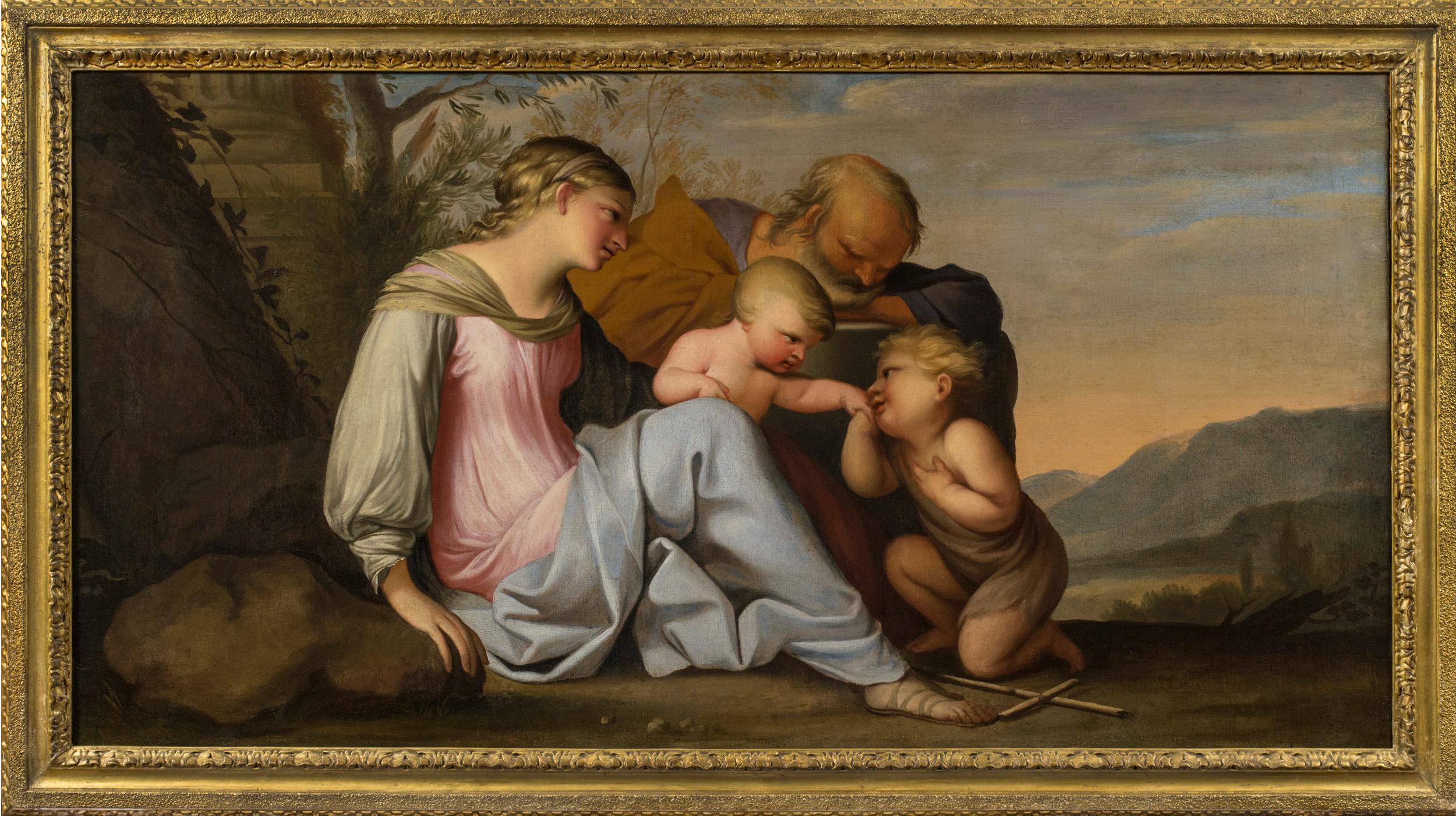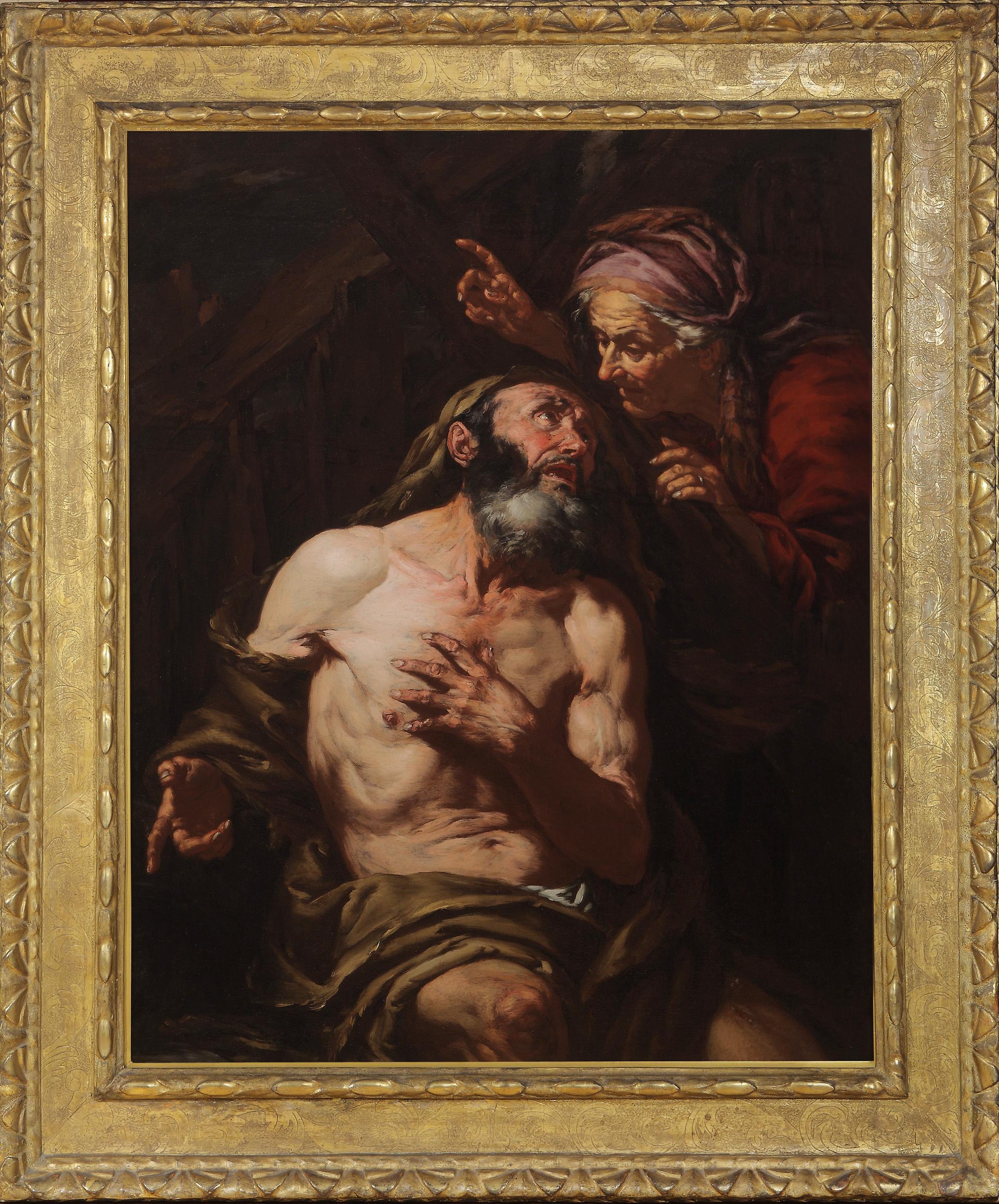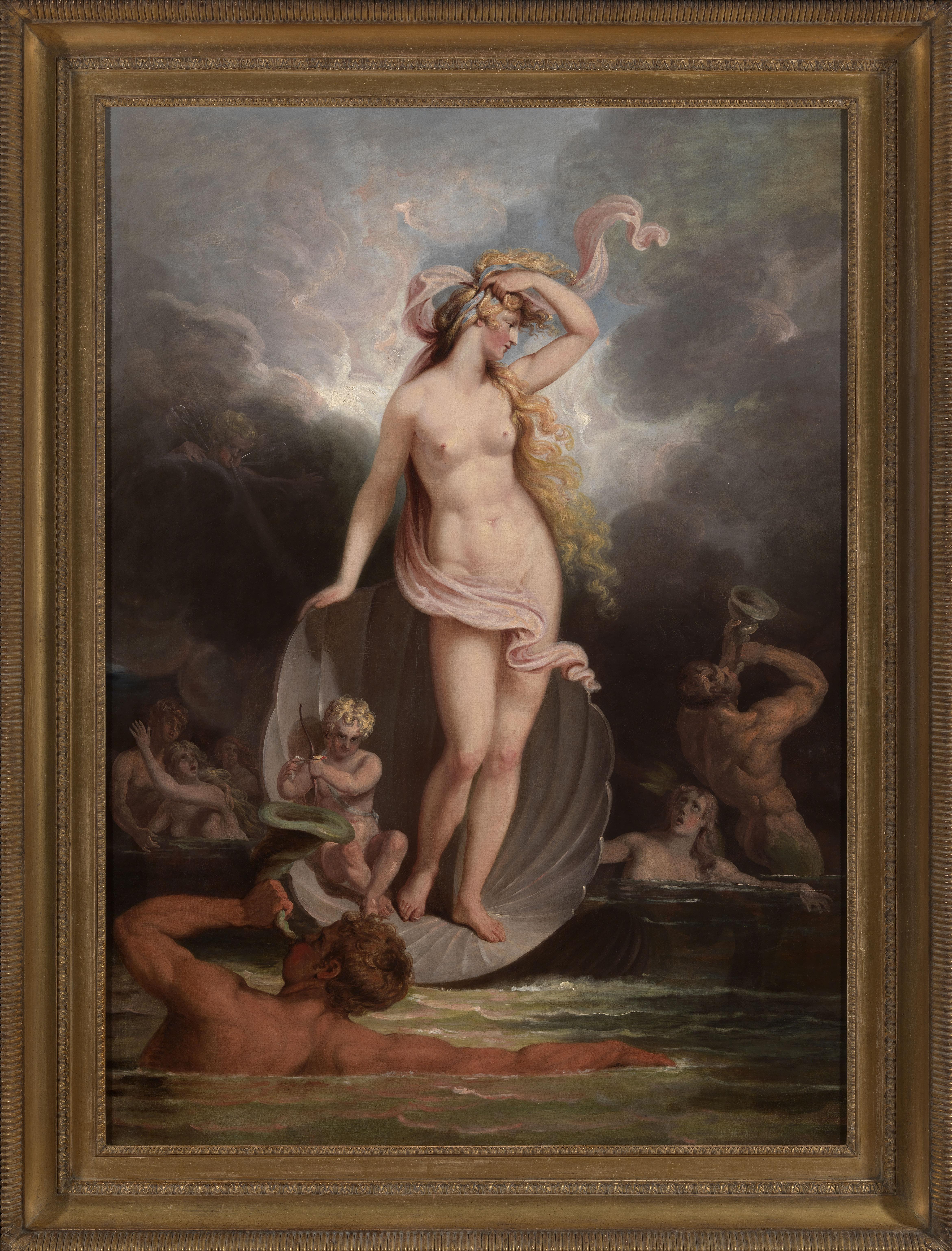Items Similar to Jean-Marc Nattier (1685 - 1766) - Portrait of Charlotte de Hesse-Rheinfels
Want more images or videos?
Request additional images or videos from the seller
1 of 12
Jean-Marc NattierJean-Marc Nattier (1685 - 1766) - Portrait of Charlotte de Hesse-Rheinfels
About the Item
Jean-Marc Nattier (Paris, 1685 - 1766) and his workshop
Portrait of Charlotte de Hesse-Rheinfels
Oil on canvas : h. 44.09 in, w. 38.19 in
18th century carved giltwood framed
Framed : h. 52.36 in, w. 47.63 in
Charlotte de Hesse-Rheinfels (1714-1741), daughter of Landgrave Ernest-Léopold de Hesse-Rheinfels-Rotenburg and Éléonore de Lowenstein-Wertheim and Kazazyan, was Princess of Condé by her marriage in 1728 to Duke Louis-Henri de Bourbon-Condé known as Monsieur le Duc.
The princess is portrayed seated on a canopy of gilded wood trimmed with raspberry red velvet, the body positioned facing forward while the face is turned three-quarters to the left. The face with a thoughtful and thoughtful gaze is awakened by its large gray eyes, the translucent skin with painted cheeks accentuates the effect of a melted execution of the model. Her powdered and tied hair is adorned with an orange veil which goes down on her shoulders. The separation fades between the powdered hair and the face. Dressed in a golden yellow satin dress embellished with multiple rows of white and black lace flounces at the bodice and sleeves, the neckline of her dress reveals her bare throat. The ermine coat lined with blue velvet is placed behind his shoulders, the sides of the coat come back to the front and are arranged in angular folds on his knees. With her right hand, arm bent at the elbow, she caresses her little dog, while the left arm resting on the armrest of the armchair is extended and the index finger of her open hand points to the right. The positions of the arms and the head generate an illusion of diagonal movement allowing to break the static character of portrait. This stretching of the arms horizontally is characteristic of Nattier's works, the figure thus grows in size in the painting by occupying a larger place there. This process carried out by highlighting the elegance of refined gestures increases the natural grace of the young woman. The sober architectural background is composed of a column draped with a green curtain and flattened pilasters with Ionian capitals. The light coming from the right partially illuminates the figure, leaving the left part in shadow. Illuminated, the young woman's dress reflects golden reflections in warm orange tones, while the velvet of the coat broken into angular folds reveals its surface through icy white ridges. This opposition only accentuates the volumes and textures of the fabrics. The facial features under a subtle effect of blurred appear more softened while the pearly white complexions seem illuminated with an inner radiance.
Related works:
Our work is a variant of the painting executed by Jean Marc Nattier, kept at the Museum of Fine Arts in Buenos Aires, Argentina. Signed and dated, but the illegible date makes it impossible to establish a precise dating.
In our version, the dress with a lace corset is preferred to the negligee of the Buenos Aires version, the console is absent. The little dog with the red bow is added on the knees.
The Condés are the first blood princes among Jean Marc Nattier's clients. He began to work in 1729 for the sisters of Louis Henri de Bourbon, Mlle de Clermont and subsequently painted the portrait of Mlle de Charolais in 1731. It is very likely that it was during this period, delighted by the quality of the portraits of his sisters, that the Prince of Condé commissioned the portrait of his wife Charlotte from Nattier. Requested in the 1740s by the royal family, Jean Marc Nattier returned to paint the Condés again in 1753 & 1754.
There are no traces of the signed portrait of Buenos Aires in the inventories of the Condé family. Its known provenance dates back only to the middle of the 20th century.
Regarding our portrait, it appeared in 1905 in Paris in a public sale auction during the dispersal of the collection of the account of R… without further indications on its internal provenance. Undoubtedly remaining on the Parisian art market, the painting was purchased in the 1930s by a wealthy English industrialist for his Monegasque residence and is remained in his posterity until nowdays.
Jean-Marc Nattier (Paris, 1685 - 1766)
Son of a portrait painter and pupil of Rigaud, Nattier began his career as a history painter under the influence of Charles Le Brun and under the tutelage of his godfather, Jean Jouvenet . During a stay in Holland, he was approached to work for Tsar Peter the Great. In 1718, he was received into the Academy. His style is then that of the great French tradition. He uses the resources of the architectural setting and the grandiloquent expression of the characters; its chromaticism is frank. But Nattier does not know success; his ruin at the time of Law's bankruptcy forced him to turn to the more lucrative genre of portraiture. In 1728, he painted the Marshal of Saxe to order and enjoyed a certain favor from then on. It is, at more than forty years, the beginning of a new career which asserts itself with the Portrait of Mlle de Clermont taking the waters (1729). By the choice of subject as by the pictorial means, he established a new way of presenting the portrait, in which the high society of the middle of the 18th century wanted to recognize itself, which had the favor of the great amateurs of the 19th century . century. Elegance of the pose, freshness and clarity of the color, fantasy of the rendering of the accessories add to the serene and joyful expression of the female faces. Superficial works, but pleasing to the eye. The type of mythological portrait is now adopted by the ladies of the aristocracy and Nattier knows Parisian success for a dozen years. Later, received at court, he became the portrait painter of the royal family. The famous series of portraits of the daughters of Louis XV is part of an effort to recreate the portrait by integrating a topical image into the poetic world of Olympus. Nattier thus joins the paths of history painting, speculative and synthetic: the universe recreated in the portraits (such as that of Madame Henriette in Flore) joins the noble data of the allegory.
- Creator:Jean-Marc Nattier (1685 - 1766, French)
- Dimensions:Height: 52.36 in (133 cm)Width: 47.63 in (120.99 cm)
- Medium:
- Movement & Style:
- Period:1730-1739
- Condition:Very good original condition, cleaned and revarnished by our professionnal art restorer.
- Gallery Location:PARIS, FR
- Reference Number:1stDibs: LU2433214036452
About the Seller
No Reviews Yet
Vetted Seller
These experienced sellers undergo a comprehensive evaluation by our team of in-house experts.
1stDibs seller since 2023
- ShippingRetrieving quote...Ships From: PARIS, France
- Return PolicyA return for this item may be initiated within 3 days of delivery.
More From This SellerView All
- Late 17th century portrait of a French princess, daughter of Louis XIVBy Pierre GobertLocated in PARIS, FRPortrait of Françoise Marie de Bourbon, Duchess of Orléans as Venus A magnificent painting depicting the princess in all the splendour of her youth, Françoise Marie de Bourbon, known...Category
Late 17th Century Old Masters Figurative Paintings
MaterialsCanvas, Oil
- Louis XIV and his army at the crossing of the Rhine by Adam-Frans van der MeulenBy Adam Frans van der MeulenLocated in PARIS, FRAdam-Frans van der Meulen (Bruxelles, 1632 - Paris, 1690) Louis XIV and his army at the crossing of the Rhine 12 June 1672 Signed A.F VANDERMEULEN at the right low corner Oil on can...Category
1670s Old Masters Landscape Paintings
MaterialsCanvas, Oil
- A 17th c. Italian school, Capriccio with the Colosseum, circle of V. CodazziLocated in PARIS, FRA capriccio with the Colosseum in Roma 17th century Italian school Circle of Viviano Codazzi (1604-1670) Oil on canvas Dimensions: h. 35.43 in, w. 51.18 in Modern 17th century style ...Category
17th Century Old Masters Landscape Paintings
MaterialsCanvas, Oil
- Nicolas de Largillière - Portrait of a Lady, Paris, circa 1695By Nicolas de LargillièreLocated in PARIS, FRNicolas de Largillière (Paris, 1656-1746) Portrait of a lady, circa 1695 Oil on canvas (relined): 76 x 61 cm Framed: h. 97 cm, l. 82 cm To be included in the forthcoming catalogue ra...Category
1690s Old Masters Figurative Paintings
MaterialsCanvas, Oil
- Cercle of Ambrosius Francken, Adoration of the shepherds, 17th century AntwerpLocated in PARIS, FRAdoration of the shepherds, Cercle of Ambrosius Francken, Early 17th century Antwerp school Oil on oak panel: h. 55 cm, w. 43 cm (21.65 in x 16.93 in) 17th c. ebonized and moulded f...Category
Early 17th Century Old Masters Figurative Paintings
MaterialsOil, Wood Panel
- The Triumph of the Infant Bacchus, workshop of H. Van Balen, 16th c. AntwerpBy Hendrick van BalenLocated in PARIS, FRThe Triumph of the Infant Bacchus, Workshop of Hendrick Van Balen (1575-1632) Antwerp, c.1630 Oil on copper, h. 28 cm (11.02 in), w. 35 cm (13.78 in) A large Roman 17th century golden painted frame Framed: h. 52 cm (20.47 in.), w. 58 cm (22.83 in) Our finely painted work depicts The Triumph of the Bacchus as a young boy and is one of the most popular mythological subjects in Antwerp at the beginning of the 17th century. Feasting, wine and fun are the themes that constantly appeal to the public. Thus unfolds before our eyes on our painting the procession composed of nymphs, baccantes, fauns, satyrs and children, their bodies naked, partially covered with brightly coloured draperies that help to brighten up the parade. Playing various instruments, dancing and drinking, while carrying vases and poles adorned with grapevines, participants to the rhythm of a noisy brass band make their way to an ancient temple standing on the right. The exaggerated gestures convey to us the frenzy of the excited crowd. The Child Bacchus follows the joyous procession, carried by satyrs and nymphs, crowned with ivy and joyfully raising a cup of wine. In the foreground, the drunken participants leave the procession, the children on the left and the group of bacchantes and satyrs on the right are resting among various objects scattered at their feet: cups, vases, ewers bear witness to the festivities in progress. In the background, a hilly landscape stretches out on the horizon, a semblance of calm that contrasts with the bustle of the foreground. The artist strives to multiply the many details, whether it be figures, costumes, flowers or vegetation, in order to demonstrate his know-how and the perfection of his execution. The acidulous palette with fresh and varied colours is characteristic of Hendrick Van Balen's works. There are several versions identical to ours with similar dimensions painted by Hendrick Van Balen and his workshop. Related works: • Koller Auction, Zurich, 21/09/2007, oil on copper, 28,5 x 37,4 cm. • Staatliche Kunsthalle, Karlsruhe, Inv. N° 809 (oil on copper, 40 x 53,5 cm) • Auktionshaus für Altertümer Glückselig, Vienne, 10/05/1932, ( oil on copper, 34 x 42 cm) • Gemäldegalerie of Pommersfelden, Schloss Weissenstein, oil on panel, 47 x 64 cm Hendrick Van Balen, Flemish painter, born and died in Antwerp (1575-1632). A pupil of Adam Van Noort, he entered the Guild of St. Luke in 1593, later trained in Italy and was Van Dyck's first teacher. He often painted small figures taken from scenes from the Bible or classical mythology, on paintings whose backgrounds and landscapes were painted by Josse de Momper...Category
17th Century Old Masters Figurative Paintings
MaterialsCopper
You May Also Like
- Italian 18th Century Oval Religious Oil on Canvas Painting with Saint DominicBy Francesco de MuraLocated in Firenze, ITThis beautiful Italian 18th Century old masters oil painting on oval canvas with giltwood frame is attributed to Solimena and features a religious scene. In this splendid oval-shaped painting are depicted Saint Dominic...Category
18th Century Old Masters Figurative Paintings
MaterialsOil, Canvas
- Head of an AngelLocated in New York, NYProcaccini was born in Bologna, but his family moved to Milan when the artist was eleven years old. His artistic education was evidently familial— from his father Ercole and his elder brothers Camillo and Carlo Antonio, all painters—but his career began as a sculptor, and at an early age: his first known commission, a sculpted saint for the Duomo of Milan, came when he was only seventeen years old. Procaccini’s earliest documented painting, the Pietà for the Church of Santa Maria presso San Celso in Milan, was completed by 1604. By this time the artist had made the trip to Parma recorded by his biographers, where he studied Correggio, Mazzola Bedoli, and especially Parmigianino; reflections of their work are apparent throughout Procaccini's career. As Dr. Hugh Brigstocke has recently indicated, the present oil sketch is preparatory for the figure of the angel seen between the heads of the Virgin and St. Charles Borrommeo in Procaccini's altarpiece in the Church of Santa Afra in Brescia (ill. in Il Seicento Lombardo; Catalogo dei dipinti e delle sculture, exh. cat. Milan 1973, no. 98, pl. 113). As such it is the only known oil sketch of Procaccini's that can be directly connected with an extant altarpiece. The finished canvas, The Virgin and Child with Saints Charles Borrommeo and Latino with Angels, remains in the church for which it was painted; it is one of the most significant works of Procaccini's maturity and is generally dated after the artist's trip to Genoa in 1618. The Head of an Angel is an immediate study, no doubt taken from life, but one stylistically suffused with strong echoes of Correggio and Leonardo. Luigi Lanzi, writing of the completed altarpiece in 1796, specifically commented on Procaccini's indebtedness to Correggio (as well as the expressions of the angels) here: “Di Giulio Cesare...Category
17th Century Old Masters Figurative Paintings
MaterialsCanvas, Paper, Oil
- An Architectural Capriccio with the Preaching of an ApostleBy Giovanni Paolo PaniniLocated in New York, NYProvenance: Santambrogio Antichità, Milan; sold, 2007 to: Filippo Pernisa, Milan; by whom sold, 2010, to: Private Collection, Melide, Switzerland De Primi Fine Art, Lugano, Switzerland; from whom acquired, 2011 by: Private Collection, Connecticut (2011-present) Literature: Ferdinando Arisi, “Ancora sui dipinti giovanili del Panini,” Strenna Piacentina (Piacenza, 2009): pp. 48, 57, 65, fig. 31, as by Panini Ferdinando Arisi, “Panini o Ghisolfi o Carlieri? A proposito dei dipinti giovanili,” Strenna Piacentina, (Piacenza, 2010), pp. 100, 105, 116, fig. 101, as an early work by Panini, a variant of Panini’s painting in the Museo Cristiano, Esztergom, Hungary. This architectural capriccio is one of the earliest paintings by Giovanni Paolo Panini, the preeminent painter of vedute and capricci in 18th-century Rome. The attribution to Panini has been endorsed by Ferdinando Arisi, and a recent cleaning of the painting revealed the artist’s signature in the lower right. Like many of his fellow painters working in Rome during his day, Panini was not a native of the Eternal City. He first trained as a painter and stage designer in his hometown of Piacenza and moved to Rome at the age of 20 in November 1711 to study figure painting. Panini joined the workshop of Benedetto Luti (1666-1724) and from 1712 was living on the Piazza Farnese. Panini, like many before and after him, was spellbound by Rome and its classical past. He remained in the city for the rest of his career, specializing in depicting Rome’s most important monuments, as well as creating picturesque scenes like this one that evoked the city’s ancient splendor. The 18th century art historian Lione Pascoli, who likely knew Panini personally, records in his 1730 biography of the artist that when Panini came to Rome, he was already “an excellent master and a distinguished painter of perspective, landscape, and architecture.” Panini’s earliest works from this period still show the evidence of his artistic formation in Piacenza, especially the influence of the view painter Giovanni Ghisolfi (1623-1683). However, they were also clearly shaped by his contact in Rome with the architectural capricci of Alberto Carlieri...Category
18th Century Old Masters Figurative Paintings
MaterialsCanvas, Oil
- Holy Family with the Infant St. John the BaptistLocated in New York, NYLubin Baugin (Pithiviers 1610 – 1663 Paris) Holy Family with the Infant Saint John the Baptist Oil on canvas 22 x 42 ¼ inches (55.9 x 107.3 cm) Provenance: Marcello and Carlo ...Category
17th Century Old Masters Figurative Paintings
MaterialsCanvas, Oil
- Job Cursed by His WifeBy Giovanni Battista LangettiLocated in New York, NYProvenance: Alfred (1883-1961) and Hermine Stiassni (1889-1962), Brno, Czech Republic, by 1925; thence London, 1938-1940; thence Los Angeles, 1940-1962; thence by descent to: Susanne Stiassni Martin and Leonard Martin, San Francisco, until 2005; thence by descent to: Private Collection, California Exhibited: Künstlerhaus, Brünn (Brno), 1925, as by Ribera. “Art of Collecting,” Flint Institute of Art, Flint, Michigan, 23 November 2018 – 6 January 2019. Literature: Alte Meister...Category
1670s Old Masters Paintings
MaterialsCanvas, Oil
- 18th century allegorical painting of The Triumph of BeautyLocated in London, GBExhibited: London, Royal Academy, 1800, no. 93 What was happening in British history painting in around 1800? In recent discussions of the emergence of a British School of history painting following the foundation of the Royal Academy in 1768, this is a question which is rarely posed and one which is not easily answered. Examination of surviving Royal Academy exhibition catalogues reveals a profusion of artists’ names and titles, few of which remain immediately recognizable, whilst endeavours to explain the impact of exhibition culture on painting - such as the 2001 Courtauld show Art on the Line - have tended to focus on the first and second generation of Royal Academician, rather than young or aspiring artists in the early nineteenth century. This makes the discovery and identification of the work under discussion of exceptional importance in making sense of currents in English painting around 1800. Executed by Edward Dayes...Category
18th Century Old Masters Figurative Paintings
MaterialsCanvas, Oil




